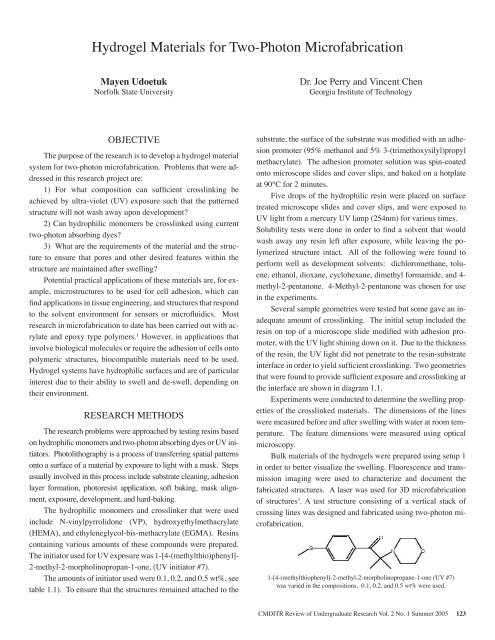Student Project Abstracts 2005 - Pluto - University of Washington
Student Project Abstracts 2005 - Pluto - University of Washington
Student Project Abstracts 2005 - Pluto - University of Washington
Create successful ePaper yourself
Turn your PDF publications into a flip-book with our unique Google optimized e-Paper software.
Hydrogel Materials for Two-Photon Micr<strong>of</strong>abricationMayen UdoetukNorfolk State <strong>University</strong>Dr. Joe Perry and Vincent ChenGeorgia Institute <strong>of</strong> TechnologyOBJECTIVEThe purpose <strong>of</strong> the research is to develop a hydrogel materialsystem for two-photon micr<strong>of</strong>abrication. Problems that were addressedin this research project are:1) For what composition can sufficient crosslinking beachieved by ultra-violet (UV) exposure such that the patternedstructure will not wash away upon development?2) Can hydrophilic monomers be crosslinked using currenttwo-photon absorbing dyes?3) What are the requirements <strong>of</strong> the material and the structureto ensure that pores and other desired features within thestructure are maintained after swelling?Potential practical applications <strong>of</strong> these materials are, for example,microstructures to be used for cell adhesion, which canfind applications in tissue engineering, and structures that respondto the solvent environment for sensors or micr<strong>of</strong>luidics. Mostresearch in micr<strong>of</strong>abrication to date has been carried out with acrylateand epoxy type polymers. 1 However, in applications thatinvolve biological molecules or require the adhesion <strong>of</strong> cells ontopolymeric structures, biocompatible materials need to be used.Hydrogel systems have hydrophilic surfaces and are <strong>of</strong> particularinterest due to their ability to swell and de-swell, depending ontheir environment.RESEARCH METHODSThe research problems were approached by testing resins basedon hydrophilic monomers and two-photon absorbing dyes or UV initiators.Photolithography is a process <strong>of</strong> transferring spatial patternsonto a surface <strong>of</strong> a material by exposure to light with a mask. Stepsusually involved in this process include substrate cleaning, adhesionlayer formation, photoresist application, s<strong>of</strong>t baking, mask alignment,exposure, development, and hard-baking.The hydrophilic monomers and crosslinker that were usedinclude N-vinylpyrrolidone (VP), hydroxyethylmethacrylate(HEMA), and ethyleneglycol-bis-methacrylate (EGMA). Resinscontaining various amounts <strong>of</strong> these compounds were prepared.The initiator used for UV exposure was 1-[4-(methylthio)phenyl]-2-methyl-2-morpholinopropan-1-one, (UV initiator #7).The amounts <strong>of</strong> initiator used were 0.1, 0.2, and 0.5 wt%, seetable 1.1). To ensure that the structures remained attached to thesubstrate, the surface <strong>of</strong> the substrate was modified with an adhesionpromoter (95% methanol and 5% 3-(trimethoxysilyl)propylmethacrylate). The adhesion promoter solution was spin-coatedonto microscope slides and cover slips, and baked on a hotplateat 90°C for 2 minutes.Five drops <strong>of</strong> the hydrophilic resin were placed on surfacetreated microscope slides and cover slips, and were exposed toUV light from a mercury UV lamp (254nm) for various times.Solubility tests were done in order to find a solvent that wouldwash away any resin left after exposure, while leaving the polymerizedstructure intact. All <strong>of</strong> the following were found toperform well as development solvents: dichloromethane, toluene,ethanol, dioxane, cyclohexane, dimethyl formamide, and 4-methyl-2-pentanone. 4-Methyl-2-pentanone was chosen for usein the experiments.Several sample geometries were tested but some gave an inadequateamount <strong>of</strong> crosslinking. The initial setup included theresin on top <strong>of</strong> a microscope slide modified with adhesion promoter,with the UV light shining down on it. Due to the thickness<strong>of</strong> the resin, the UV light did not penetrate to the resin-substrateinterface in order to yield sufficient crosslinking. Two geometriesthat were found to provide sufficient exposure and crosslinking atthe interface are shown in diagram 1.1.Experiments were conducted to determine the swelling properties<strong>of</strong> the crosslinked materials. The dimensions <strong>of</strong> the lineswere measured before and after swelling with water at room temperature.The feature dimensions were measured using opticalmicroscopy.Bulk materials <strong>of</strong> the hydrogels were prepared using setup 1in order to better visualize the swelling. Fluorescence and transmissionimaging were used to characterize and document thefabricated structures. A laser was used for 3D micr<strong>of</strong>abrication<strong>of</strong> structures 3 . A test structure consisting <strong>of</strong> a vertical stack <strong>of</strong>crossing lines was designed and fabricated using two-photon micr<strong>of</strong>abrication.1-[4-(methylthiophenyl]-2-methyl-2-morpholinopropane-1-one (UV #7)was varied in the compositions. 0.1, 0.2, and 0.5 wt% were used.CMDITR Review <strong>of</strong> Undergraduate Research Vol. 2 No. 1 Summer <strong>2005</strong> 123




